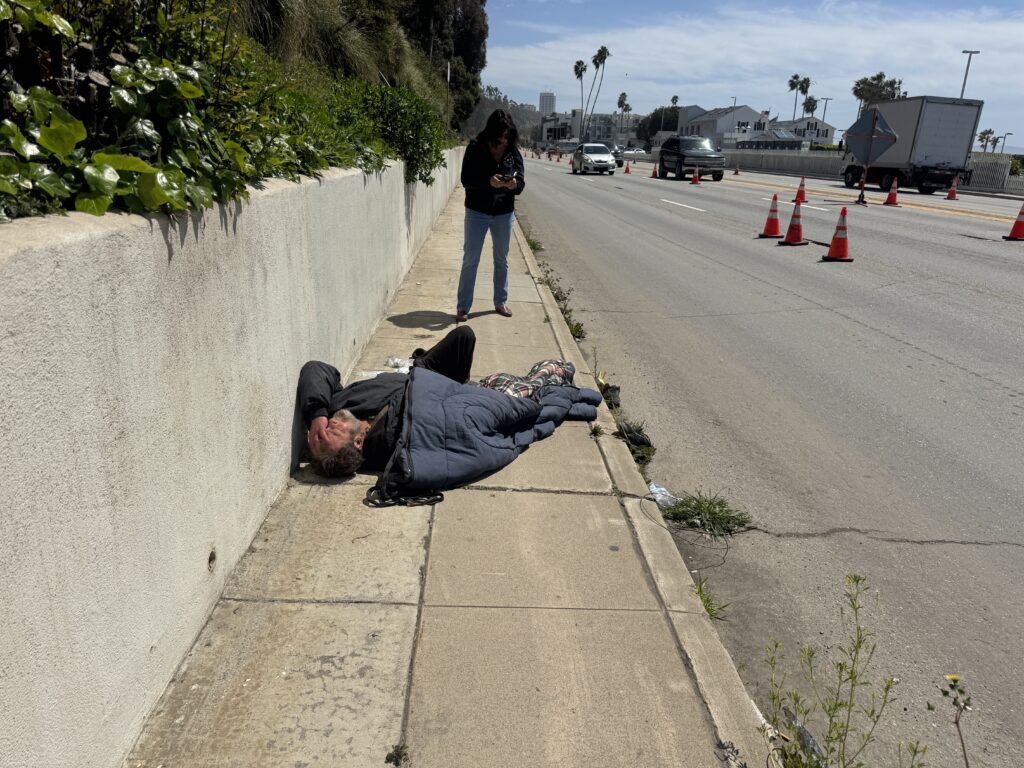
The jump in sales tax to 9.75% is intended to help people like this man who was sleeping along PCH, his shoes were in the curb. Police helped him move across the roadway, so he wouldn’t accidentally stumble out and get hit. He said he didn’t want help.
(Editor’s note: This appeared in the Westside Current today and is reprinted with permission.)
By JAMIE PAIGE
A new quarter-cent sales tax to fund homelessness programs in Los Angeles County takes effect Tuesday — raising the county’s base sales tax from 9.5% to 9.75% — just days after a federal judge publicly questioned how previous funds for homelessness were handled.
The timing has raised new concerns about transparency and accountability, especially in light of revelations that tens of millions in public dollars may have been mismanaged by agencies tasked with addressing the region’s homelessness crisis.
Measure A — formally titled the Affordable Housing, Homelessness Solutions and Prevention Now — replaces Measure H, a half-cent tax approved by voters in 2017 that was set to expire in 2027. Unlike its predecessor, Measure A is permanent unless repealed by voters.
Roughly 60% of the tax’s revenue is earmarked for homelessness services, with another 35.75% allocated to the newly formed L.A. County Affordable Housing Solutions Agency. Fifteen percent will be distributed to cities based on their annual homeless population counts.
But just last week, during a federal court hearing in the LA Alliance for Human Rights case, U.S. District Judge David O. Carter said the Los Angeles Homeless Services Authority (LAHSA) had been the subject of 18 years’ worth of audits, many of which revealed systemic mismanagement of funds. He accused the county of intentionally withholding a recent internal audit — conducted before the November vote on Measure A — from the public.
“The people deserve to know where their money is going,” Carter said in court, calling the lack of transparency “deeply troubling.”
The review uncovered widespread failures in how homelessness funds were managed by LAHSA, the joint city-county agency responsible for coordinating homeless services throughout the region.
According to the audit, one of the most striking findings revealed that LAHSA had issued more than $50 million in Measure H-funded cash advances to subcontracted service providers beginning in 2017, without any formal agreements outlining how — or even if — the money would be repaid.
As of July 2024, LAHSA had recovered just $2.5 million — or 5% — of the $50 million in advances distributed over the seven-year period. The majority of the funds remain outstanding.
Adding to those concerns, Judge Carter also referenced a separate, court-ordered audit conducted by the private consulting firm Alvarez & Marsal (A&M), which examined more than $2.3 billion in homelessness spending across three major programs, including Mayor Karen Bass’s Inside Safe initiative. The report uncovered unreliable financial records, fragmented oversight, and little clarity on how taxpayer dollars were being tracked or spent.
A&M reported that fragmented data systems across LAHSA, the city, and the county — combined with inconsistent reporting formats — made it difficult to verify expenditures, assess bed counts, or measure performance.
“The lack of uniform data standards and real-time oversight increased the risk of resource misallocation and limited the ability to assess the true impact of homelessness assistance services,” the firm concluded.
According to court filings, LAHSA did not initially provide all requested financial data, forcing A&M to make repeated requests in order to reconcile expenditures. As a result, auditors were unable to quantify the total amount spent by the city to create shelter beds or deliver supportive services.
Nevertheless, despite the troubling findings from both audits, the Los Angeles County Board of Supervisors moved forward last week with the approval of a $656 million spending plan funded by Measure A revenues. The plan also draws on $209 million in unspent Measure H funds and $42.6 million in state grants.
The Los Angeles City Council has already approved a similar motion, calling for a study on how to bypass LAHSA and manage contracts with homeless service providers directly.
While LAHSA has disputed parts of both audits, the agency acknowledged the need for improvement and pointed to reforms already underway, including the launch of new data dashboards and systems for real-time tracking of shelter availability and services.
Preliminary results from the 2025 homeless count indicate a 5% to 10% decrease in unsheltered homelessness across the region.
Still, as Measure A takes effect and residents begin contributing to a new round of public funding, questions remain about whether the systems in place are sufficiently reformed — or equipped — to manage the money effectively.
